A+ solution
Here, you'll find high-quality, well-organized study materials to help you succeed in your academic journey. Whether you're looking for detailed lecture notes, exam summaries, or practical guides, my resources are created to make studying more efficient and effective.
All materials are carefully curated, based on reliable sources, and formatted for easy understanding. From key concepts to critical insights, I’ve got you covered!
Let’s make learning easier—browse my content and ace your studies today!
- 148
- 0
- 0
Community
- Followers
- Following
148 items
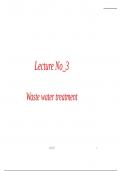
Lecture No_3 Waste water treatment
1.1 Introduction To remove contaminants from waste water there are three mechanisms 1 . Physical Mainly physical properties like Screening Sedimentation Floatation Filtration 2. Chemical Chemical properties like Precipitation Coagulation Disinfection A.B@JiT 2 Cont’d 3. Biological The biological includes Biological filtration Activated sludge Combination of physical and chemical process Air striping Carbon adsorption Oxidation ...
- Class notes
- • 149 pages •
1.1 Introduction To remove contaminants from waste water there are three mechanisms 1 . Physical Mainly physical properties like Screening Sedimentation Floatation Filtration 2. Chemical Chemical properties like Precipitation Coagulation Disinfection A.B@JiT 2 Cont’d 3. Biological The biological includes Biological filtration Activated sludge Combination of physical and chemical process Air striping Carbon adsorption Oxidation ...
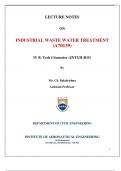
INDUSTRIAL WASTE WATER TREATMENT (A70139)
UNIT- I Sources of Industrial Waste Industrial wastewater means used up water from industries. The characteristics of waters depend on the nature of industry. Sources of Industrial Waste Water Agricultural Waste The agricultural sector produces an enormous volume of wastewater every year. The two main sources of wastewater in agriculture are: a) non-point source pollution and b) point source pollution. Non point source pollution is generally a result of surface run offs from fields, e...
- Class notes
- • 101 pages •
UNIT- I Sources of Industrial Waste Industrial wastewater means used up water from industries. The characteristics of waters depend on the nature of industry. Sources of Industrial Waste Water Agricultural Waste The agricultural sector produces an enormous volume of wastewater every year. The two main sources of wastewater in agriculture are: a) non-point source pollution and b) point source pollution. Non point source pollution is generally a result of surface run offs from fields, e...
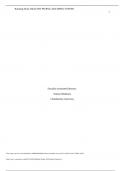
HEALTHY PEOPLE 2020 IMPACT PAPER
Sexually transmitted diseases Nneka Obidimma Chamberlain University
- Exam (elaborations)
- • 5 pages •
Sexually transmitted diseases Nneka Obidimma Chamberlain University
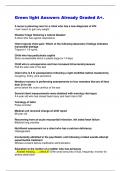
Green light Answers Already Graded A+.
Green light Answers Already Graded A+. A nurse is planning care for a client who has a new diagnosis of HIV. I can’t seem to gain any weight Disaster triage following a natural disaster A client who has agonal respirations Client reports chest pain. Which of the following laboratory findings indicates myocardial damage Troponin I 1.8 ng/mL Child who has pediculosis capitis Store nonwashable items in plastic bags for 14 days Child who is unresponsive and has increased intracranial pre...
- Exam (elaborations)
- • 17 pages •
Green light Answers Already Graded A+. A nurse is planning care for a client who has a new diagnosis of HIV. I can’t seem to gain any weight Disaster triage following a natural disaster A client who has agonal respirations Client reports chest pain. Which of the following laboratory findings indicates myocardial damage Troponin I 1.8 ng/mL Child who has pediculosis capitis Store nonwashable items in plastic bags for 14 days Child who is unresponsive and has increased intracranial pre...
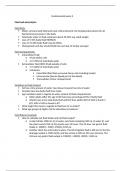
Fluid and electrolytes
Fundamentals exam 2 Fluid and electrolytes Fluid Facts Water- primary body fluid and most critical element; the fundamental solvent for all biochemical processes in the body Total body water or fluid comprises about 50-40% avg. adult weight Loss of 5-10% body fluid=SERIOUS Loss of 15-20% body fluid=may be FATAL Fluid gained each day should=fluid lost each day (2-3L/day average) Fluid Compartments Intracellular Fluid: o =Fluid within cells o -2/3 (70%) of t...
- Exam (elaborations)
- • 61 pages •
Fundamentals exam 2 Fluid and electrolytes Fluid Facts Water- primary body fluid and most critical element; the fundamental solvent for all biochemical processes in the body Total body water or fluid comprises about 50-40% avg. adult weight Loss of 5-10% body fluid=SERIOUS Loss of 15-20% body fluid=may be FATAL Fluid gained each day should=fluid lost each day (2-3L/day average) Fluid Compartments Intracellular Fluid: o =Fluid within cells o -2/3 (70%) of t...
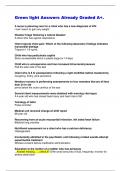
Green light Answers Already Graded A+.
Green light Answers Already Graded A+. A nurse is planning care for a client who has a new diagnosis of HIV. I can’t seem to gain any weight Disaster triage following a natural disaster A client who has agonal respirations Client reports chest pain. Which of the following laboratory findings indicates myocardial damage Troponin I 1.8 ng/mL Child who has pediculosis capitis Store nonwashable items in plastic bags for 14 days Child who is unresponsive and has increased intracranial pre...
- Exam (elaborations)
- • 17 pages •
Green light Answers Already Graded A+. A nurse is planning care for a client who has a new diagnosis of HIV. I can’t seem to gain any weight Disaster triage following a natural disaster A client who has agonal respirations Client reports chest pain. Which of the following laboratory findings indicates myocardial damage Troponin I 1.8 ng/mL Child who has pediculosis capitis Store nonwashable items in plastic bags for 14 days Child who is unresponsive and has increased intracranial pre...
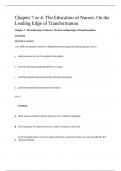
The Education of Nurses TEST BANK
Test Bank MULTIPLE CHOICE 1. In 1900, the primary reason for hospital-based nursing education programs was to a. educate nurses to care for patients in hospitals. b. provide educational opportunities for women. c. staff the hospitals that operated the education programs. d. provide standardized preparation for nurses. ANS: C Feedback A Most nurses worked in homes and very few worked in hospitals. B The education for women was not a value of society at the time. In the hospitals there ...
- Exam (elaborations)
- • 108 pages •
Test Bank MULTIPLE CHOICE 1. In 1900, the primary reason for hospital-based nursing education programs was to a. educate nurses to care for patients in hospitals. b. provide educational opportunities for women. c. staff the hospitals that operated the education programs. d. provide standardized preparation for nurses. ANS: C Feedback A Most nurses worked in homes and very few worked in hospitals. B The education for women was not a value of society at the time. In the hospitals there ...
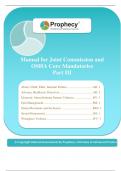
Manual for Joint Commission and OSHA Core Mandatories Part III
INTRODUCTION Three types of abuse that may be seen in the healthcare setting are child abuse, elder abuse, and intimate partner violence, also known as domestic violence. The abuse of one person by another can take many forms – physical, emotional, psychological, sexual, and more. The statistics regarding abuse are disturbing: In 2014, more than 700,000 children were abused and/or neglected in the U.S. In 2015, more than 2.1 million cases of elder abuse were reported in the U.S....
- Summary
- • 90 pages •
INTRODUCTION Three types of abuse that may be seen in the healthcare setting are child abuse, elder abuse, and intimate partner violence, also known as domestic violence. The abuse of one person by another can take many forms – physical, emotional, psychological, sexual, and more. The statistics regarding abuse are disturbing: In 2014, more than 700,000 children were abused and/or neglected in the U.S. In 2015, more than 2.1 million cases of elder abuse were reported in the U.S....
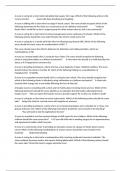
Comprehensive_Assesment B
A nurse is caring for a client who had abdominal surgery 24 hr ago. Which of the following actions is the nurse's priority? Assist with deep breathing and coughing A nurse is talking with a client who has stage IV breast cancer. The nurse should recognize which of the following statements by the client as a constructive use of a defense mechanism? "I told my doctor that I would like to start a support group for other women who are sick in my community" A nurse is caring for a client w...
- Exam (elaborations)
- • 17 pages •
A nurse is caring for a client who had abdominal surgery 24 hr ago. Which of the following actions is the nurse's priority? Assist with deep breathing and coughing A nurse is talking with a client who has stage IV breast cancer. The nurse should recognize which of the following statements by the client as a constructive use of a defense mechanism? "I told my doctor that I would like to start a support group for other women who are sick in my community" A nurse is caring for a client w...

EMT FISDAP READINESS EXAM 2 QUESTIONS AND ANSWERS (LATEST 2022/2023)
EMT FISDAP READINESS EXAM 2 QUESTIONS AND ANSWERS (LATEST 2022/2023) The collective set of regulations and ethical considerations governing the EMT is called: A. Duty of act B. Scope of practice C. Advance directives D. Good Samaritan law -answer- B Legislation that governs the skills and medical interventions that may be performed by an EMT is: A. Standardized (uniform) throughout the country B. Different from state to state C. Standardized (uniform) for regions within a state D. Go...
- Exam (elaborations)
- • 7 pages •
EMT FISDAP READINESS EXAM 2 QUESTIONS AND ANSWERS (LATEST 2022/2023) The collective set of regulations and ethical considerations governing the EMT is called: A. Duty of act B. Scope of practice C. Advance directives D. Good Samaritan law -answer- B Legislation that governs the skills and medical interventions that may be performed by an EMT is: A. Standardized (uniform) throughout the country B. Different from state to state C. Standardized (uniform) for regions within a state D. Go...
